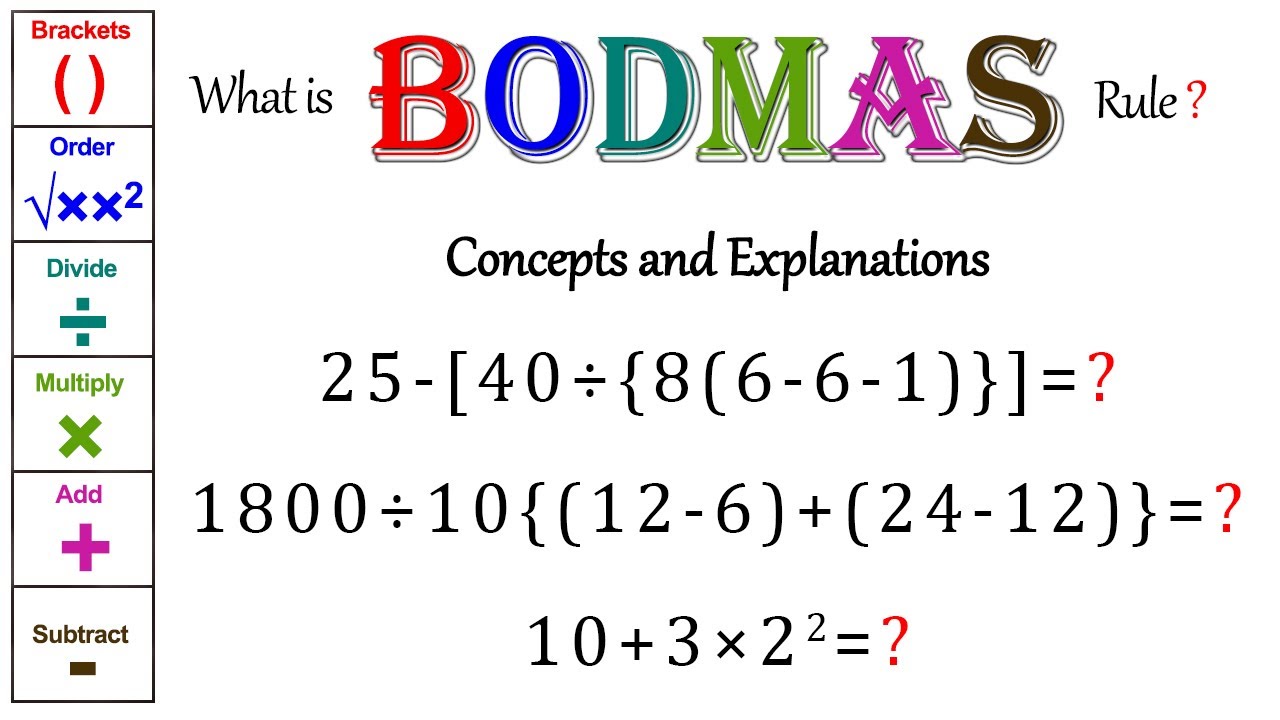BODMAS stands for Parentheses (aka Parentheses), Order of Subscripts, Multiplication and Division, Subtraction and Addition.
BODMAS describes the sequence of operations in a mathematical equation. It is a basic mathematical idea that is used in many situations where complex equations need to be solved.
It simplifies problem-solving and, in most cases, reduces computation time. Therefore, a clear understanding of the concept is essential from the outset.
BODMAS is a set of mathematical and computer programming rules that represent the standards by which procedures should be followed to evaluate a given mathematical proposition.
These rules avoid symbol ambiguity while allowing the shortest possible notation. When it is intended to override or simply emphasize precedence conventions, parentheses () may be used.
Assume that a mathematical expression requires several pairs of parentheses (as in the case of nested parentheses). Square brackets or curly braces can replace parentheses.
Compared with operations involving two integers, an arithmetic operation that requires many functions such as addition, subtraction, multiplication, and division is difficult to answer. A two-digit procedure is simple.
But how do I solve an expression with parentheses and some math, and how do I simplify the parentheses? Review the BODMAS rule and learn about simplifying parentheses.
Sure, here are some BODMAS questions:
Evaluate the expression: 5 + 4 x 3 ÷ 6 – 2
Solution:
5 + 4 x 3 ÷ 6 – 2 = 5 + 2 – 2 = 5
Evaluate the expression: 3 + 4 x 5 – 2 ÷ 6
Solution:
3 + 4 x 5 – 2 ÷ 6 = 3 + 20 – 0.33 = 22.67
Simplify the expression: 12 ÷ 4 + 5 x 2 – 3
Solution:
12 ÷ 4 + 5 x 2 – 3 = 3 + 10 – 3 = 10
Simplify the expression: 8 – 3 x 2 + 6 ÷ 3
Solution:
8 – 3 x 2 + 6 ÷ 3 = 8 – 6 + 2 = 4
Evaluate the expression: 2 x (3 + 5) ÷ 4 + 1
Solution:
2 x (3 + 5) ÷ 4 + 1 = 16 ÷ 4 + 1 = 4 + 1 = 5
Remember, BODMAS stands for “Brackets, Orders, Division, Multiplication, Addition, Subtraction” and it is a rule for the order of operations when solving mathematical expressions.
Common Misconception
One common misconception is that multiplication must always be done before division, and addition must always be done before subtraction. This is not necessarily true, as BODMAS (or PEMDAS) states that multiplication and division are at the same level of precedence, as are addition and subtraction.
The correct order of operations depends on the specific expression being evaluated. In general, parentheses should be evaluated first, then any exponents, followed by multiplication and division (in whichever order they occur from left to right), and finally addition and subtraction (in whichever order they occur from left to right).
Another common misconception is that the order of operations is always left to right. However, this is also not necessarily true. The correct order of operations depends on the specific expression being evaluated and may involve evaluating parts of the expression out of order in order to correctly follow the rules of BODMAS.
BODMAS Rule
BODMAS is a rule used to determine the order of operations when evaluating mathematical expressions. It stands for:
B – Brackets (or Parentheses)
O – Orders (or Exponents)
D – Division
M – Multiplication
A – Addition
S – Subtraction
The rule states that, when evaluating an expression, you should first perform any calculations inside brackets or parentheses. Then, you should evaluate any exponents or orders. Next, you should perform any multiplication or division, working from left to right. Finally, you should perform any addition or subtraction, again working from left to right.
By following the BODMAS rule, you can ensure that you perform the correct calculations in the correct order. This is important because, if you perform the operations in the wrong order, you can end up with an incorrect result. The BODMAS rule provides a clear and consistent framework for performing calculations, making it easier to solve complex mathematical problems accurately.
BODMAS vs. PEMDAS
BODMAS and PEMDAS are both rules used to determine the order of operations when evaluating mathematical expressions. They are two different acronyms that represent the same order of operations, but with different wording.
BODMAS stands for:
B – Brackets (or Parentheses)
O – Orders (or Exponents)
D – Division
M – Multiplication
A – Addition
S – Subtraction
PEMDAS stands for:
P – Parentheses (or Brackets)
E – Exponents (or Orders)
M – Multiplication
D – Division
A – Addition
S – Subtraction
Both BODMAS and PEMDAS state that you should first perform any calculations inside parentheses or brackets, then any exponents or orders, then any multiplication or division (in whichever order they occur from left to right), and finally any addition or subtraction (in whichever order they occur from left to right).
The main difference between the two rules is the order in which they list the brackets/parentheses and exponents/orders. BODMAS lists them in the opposite order to PEMDAS. In practice, both rules will give the same result if used correctly.
It is worth noting that, while BODMAS is commonly used in the UK, PEMDAS is more commonly used in the USA.
How to Solve BODMAS Questions?
To solve BODMAS questions, you should follow the order of operations as per the BODMAS rule. Here are the steps you should take:
Start by identifying any brackets or parentheses in the expression, and evaluate the contents of these first. Work from the innermost set of brackets outward.
If there are any exponents or orders (i.e., numbers raised to a power or square roots), evaluate these next.
Next, evaluate any multiplication or division in the expression. Work from left to right, performing any multiplication or division operations that come first.
Finally, evaluate any addition or subtraction in the expression. Work from left to right, performing any addition or subtraction operations that come first.
By following these steps, you can ensure that you perform the correct calculations in the correct order, and arrive at the correct answer. It can also be helpful to use a calculator to perform the calculations, especially for more complex expressions.
Remember to pay close attention to the order of operations and any parentheses or brackets, as failing to do so can result in an incorrect answer.
BODMAS Questions Example
Sure, here’s an example of a BODMAS question:
Evaluate: 5 + 2 x (8 – 3) / 2
Using the BODMAS rule, we would start by working inside the brackets first:
5 + 2 x 5 / 2
Next, we would perform the multiplication and division in order, working from left to right:
5 + 10 / 2. This would result in 5 + 5 = 10.
Therefore, the answer to the expression is 10.
It’s important to note that, if you were to perform the addition first instead of following the BODMAS rule, you would get a different answer:
5 + 2 x (8 – 3) / 2 = 5 + 2 x 5 / 2 = 5 + 5 = 10 (Correct)
However, if you were to perform the addition before the division, you would get a different answer:
5 + 2 x (8 – 3) / 2 = 5 + 2 x 5 = 5 + 10 = 15 (Incorrect)
This example shows why it’s important to follow the BODMAS rule when evaluating mathematical expressions.
Solved Questions and Answers
Sure, here are some solved BODMAS questions and their answers:
Q. Evaluate: 3 x (2 + 5) – 4
Solution: First, we evaluate the contents of the brackets:
3 x 7 – 4
Next, we perform the multiplication:
21 – 4
Finally, we perform the subtraction:
17
Q. Therefore, the answer is 17.
Evaluate: 15 – 6 / 2 x (4 + 1)
Solution: First, we evaluate the contents of the brackets:
15 – 6 / 2 x 5
Next, we perform the division:
15 – 3 x 5
Finally, we perform multiplication and subtraction:
0
Q. Therefore, the answer is 0.
Evaluate: 8 + 4 x 3 / 6 – 2
Solution: First, we perform the multiplication and division in order:
8 + 2 – 2
Next, we perform the addition and subtraction in order:
8
Q. Therefore, the answer is 8.
Evaluate: 10 – 3 x 2 + 8 / 4
Solution: First, we perform the multiplication and division in order:
10 – 6 + 2
Next, we perform the addition and subtraction in order:
6
Q. Therefore, the answer is 6.
Evaluate: (2 x 3) + (4 x 5) / (6 – 1)
Solution: First, we evaluate the contents of the brackets:
6 + 20 / 5
Next, we perform the division:
6 + 4
Finally, we perform the addition:
10
Therefore, the answer is 10.
These examples show how to apply the BODMAS rule to solve mathematical expressions.
frequently asked questions BODMAS
Here are some frequently asked questions (FAQs) about BODMAS:
Q: What is BODMAS?
A: BODMAS is a rule used to determine the order of operations when evaluating mathematical expressions. It stands for Brackets (or Parentheses), Orders (or Exponents), Division, Multiplication, Addition, and Subtraction.
Q: What is the purpose of BODMAS?
A: The purpose of BODMAS is to provide a clear and consistent framework for performing calculations in the correct order, thereby ensuring that the correct result is obtained.
Q: What happens if I don’t follow the BODMAS rule?
A: If you don’t follow the BODMAS rule, you may end up with an incorrect result. This is because the order in which you perform calculations can affect the outcome of the expression.
Q: What is the difference between BODMAS and PEMDAS?
A: BODMAS and PEMDAS are two different acronyms that represent the same order of operations, but with different wording. BODMAS stands for Brackets, Orders, Division, Multiplication, Addition, and Subtraction, while PEMDAS stands for Parentheses, Exponents, Multiplication, Division, Addition, and Subtraction.
Q: Is it always necessary to use BODMAS?
A: Yes, it is important to use BODMAS or another order of operations rule when evaluating mathematical expressions to ensure.
Also Read: My vision for india in 2047













